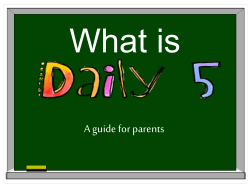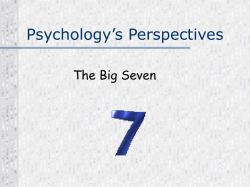
Apache Wicket: web applications with just Java Xavier Hanin JavaZone ‘07
Apache Wicket:
web applications with just Java
Xavier Hanin
JavaZone ‘07
Who is Xavier Hanin
• Independent Java Consultant
• Customers
Renault
• Open Source
Agenda
•
•
•
•
What is Wicket
Core concepts of Wicket
Developing a custom component
Q&A
Wicket in a Nutshell
•
•
•
•
•
Open Source (Apache Software Foundation)
Component based
Pure Java + Pure HTML
Simple
Enthusiastic community
What is Wicket?
• The technology: enabling componentoriented, programmatic manipulation of
markup
• The mission: bringing object oriented
programming to the web application view
layer
• The reward: have a fun job and be good
friends with your manager again
Achieving these goals through
• Keeping simple things simple
• Utilizing an object-oriented component model
where components are truly self contained
• Re-applying the Model View Controller pattern
on components instead of requests, with models
as first class citizens
• Having a clean separation of concerns between
HTML and Java
Achieving these goals through
• Providing transparent, fully automated
state management
• Keeping configuration needs to the
minimum
• No more XML!
• Making using & creating custom
components easier than any framework
out there
Component versus ‘traditional’
• Traditional
– Struts, WebWork, Spring MVC, etc.
– Proven for web
– A lot of web developers available
• Components
– JSF, Wicket, Tapestry, etc.
– Traditional model for UI development on thick
clients
– A lot of developers available
Features
• Page composition
– panels, borders and markup inheritance
• Excellent localization and style support
– template and resource loading (_be.html,
.xml)
– localized models (e.g. for labels)
– sophisticated resource bundle lookup
(composition & inheritance hierarchy)
– automatic client capabilities detection
Features
• Integration
–
–
–
–
–
Spring
Guice
Hibernate
JasperReports
OSGi
• Fancy components
– sortable, filterable, pageable, data aware tables
– date picker, rich text editor, Google Maps
– tabbed panel, navigation, tree, wizard
Features
• State management
– type safe sessions
• clustering support
• back button support
• Double submit strategies
– render redirect/ redirect to buffered response/ none
• Testing support
– JUnit testing
• extensive logging and error reporting
Features
• Ajax support and components
– Ajax without writing JavaScript, Dojo,
Scriptaculous, ...
• Header contribution
– Javascript & CSS
• URL mounting
– pretty URLs
• Component level security
Agenda
•
•
•
•
What is Wicket
Core concepts of Wicket
Developing a custom component
Q&A
Wicket’s concepts
•
•
•
•
•
•
Application
Session
RequestCycle
Components
Behaviors
Models
Application
• Main entry point for your web application
• Configuration
– Output Wicket specific tags?
– Watch for markup changes every …?
– Defines homepage
• Factories for
– Session
– RequestCycle
– Security
–…
Application
• Configured in web.xml:
<filter>
<filter-name>wicket</servlet-name>
<filter-class>
org.apache.wicket.protocol.http.WicketFilter
</filter-class>
<init-param>
<param-name>applicationClassName</param-name>
<param-value>example.MyApplication</param-value>
</init-param>
<load-on-startup>1</load-on-startup>
</filter>
Wicket’s concepts
•
•
•
•
•
•
Application
Session
RequestCycle
Components
Behaviors
Models
Session
• Abstraction of a user session
• Storage typically in HttpSession
• Stores session specific data
– Locale, Client info (browser vendor and
version)
– Your own data?
• Logged in user
• Shopping cart contents
– Limited page history for back button support
Session
class MySession extends WebSession {
private ShoppingCart cart;
public ShoppingCart getCart() { … }
public void setCart(ShoppingCart cart) { … }
}
mysession.setCart(new ShoppingCart());
…
ShoppingCart cart = mysession.getCart();
cart.add(quantity, selectedProduct);
Wicket’s concepts
•
•
•
•
•
•
Application
Session
RequestCycle
Components
Behaviors
Models
RequestCycle
• Steps in a request cycle:
1.Create request cycle object
2.Decode the request
3.Identify request target (page, component, …)
4.Process event (onClick, onSubmit, …)
5.Respond (page, component, image, pdf, …)
6.Clean up
RequestCycle
• Two types of requests:
– Stateful
• Tied to specific user session
• Not bookmarkable
– Stateless
• Not necessarily tied to specific user session
• Bookmarkable
Wicket’s concepts
•
•
•
•
•
•
Application
Session
RequestCycle
Components
Behaviors
Models
Components
• encapsulate the programmatic
manipulation of markup
• can receive an event
– onClick, onSubmit
• know how and where to render itself
Component
• Ultimate super class wicket.Component
–
–
–
–
–
–
–
–
–
Label
MultiLineLabel
TextField
PasswordTextField
Image
Link
Tree
BookmarkablePageLink
JasperReports
–
–
–
–
–
–
–
–
–
ListView
Loop
PagingNavigator
ImageMap
Button
Ajax…
Sorting, paging repeaters
Wizard
DatePicker
Components and markup
• A component is identified in markup with wicket:id
Html:
<h1 wicket:id=“msg”>Gets replaced</h1>
Java:
new Label(“msg”, “Hello, World!”);
Final (wicket tags can be stripped):
<h1>Hello, World!</h1>
Components and markup
• Component can have its own markup file
– Page
– Panel
– Border
• Put java, markup and supporting files in
same package on class path
A page: Hello, World!
Wicket’s concepts
•
•
•
•
•
•
Application
Session
RequestCycle
Components
Behaviors
Models
Behaviors
• Behaviors are plug-ins for Components
• They can modify the components markup
item.add(new AbstractBehavior() {
public void onComponentTag(
Component component, ComponentTag tag) {
String css = (((Item)component).getIndex() % 2 == 0)
? "even" : "odd";
tag.put("class", css);
}
});
Output:
<tr class=“odd”>…</tr>
<tr class=“even”>…</tr>
Behaviors
• Change attributes of your component’s markup
• Add javascript events
• Add Ajax behavior
component.add(
new AjaxSelfUpdatingBehavior(
Duration.seconds(1)));
Wicket’s concepts
•
•
•
•
•
•
Application
Session
RequestCycle
Components
Behaviors
Models
Models
• Models bind your POJO’s to Wicket components
Label(“name”, model)
<<Person>>
PropertyModel
+name : String
+city : String
Models
• Lazy binding in Java sucks
– Doesn’t update:
new TextField(“txt”, person.getName())
– Gives null pointers:
new Label(“street”, person.getAddress().getStreet())
• Solution: OGNL/EL like expressions
Models
• PropertyModel:
– new PropertyModel(person, “name”)
– new PropertyModel(person, “address.street”)
• Be aware for nulls when using updates:
Person p = new Person();
new TextField(“street”, new PropertyModel(p,
“address.street”));
Agenda
•
•
•
•
What is Wicket
Core concepts of Wicket
Developing a custom component
Q&A
Why a custom component?
• Eelco Hillenius:
« Imagine being told that you can use Java as your
programming language, but at the same time being told
not to create your own classes. [...]
I fail to understand why that has to be different for UI
development, and Wicket proves it doesn't have to be
so. »
Custom components for all
464 pages
20 minutes
Example: Password strength
weak
medium
strong
Components
• Creating custom component is as easy as
typing in ‘extends’
• Extends wicket.Component down the line
• Available on application classpath
Example: Password strength
• Panels provide grouping
–
–
–
–
Have own markup file
Can be exchanged in pages for other components
Can contribute to header
Can contain any number of components, including
panels
Example: Password strength
Example: Password strength
Example: Password strength
Components are reusable
• Put them in a JAR
• Package all necessary resources:
– HTML, JavaScript, Images, CSS
– class file
• Put JAR on classpath
• Ready for (re)use
Conclusion
• Smart component oriented web framework
• Easy creation and use of custom
components
• Enthustiatic community
Join in!
http://wicket.apache.org/
users@wicket.apache.org
Agenda
•
•
•
•
What is Wicket
Core concepts of Wicket
Developing a custom component
Q&A
© Copyright 2025









